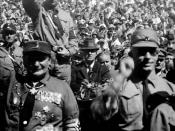Adolph Hitler's contempt for traditional German law had been manifest from his earliest days as leader of the National Socialist German Workers' Party (NSDAP).
NSDAP believed that laws should be to serve a racially defined Aryan national community, enshrined in a 'strong central state power' that would replace the democratic Constitution of 1919
Crucially, Hitler was prepared to break the law himself in order to promote and sustain his leadership of the NSDAP in German politics.
German criminal code came in September 1921 when he was arrested and later sentenced to three months imprisonment for violently disrupting a Bavarian League meeting in Munich.
Acting on rumors that Hitler was plotting a putsch, the Bavarian Minister of the Interior summoned the NSDAP leader in November and warned him personally about his provocations.
Hitler's imprisonment as the convicted leader of a banned party marked a turning point. On his release he altered course.
Once the NSDAP had been unbanned he prepared it for participation in the constitutional process.
Winning 12 seats in the Reichstag elections in 1928 was a poor showing, but the effects of the economic collapse on popular support for the major German political parties helped the Nazis to rocket to prominence in fresh elections - from ninth largest party in the Reichstag in 1928 to the largest in July 1932.
Hitler became Chancellor of Germany at the legitimate invitation of President Hindenburg on January 30 1933. The methods used henceforth by a Nazi Chancellor to 'cast the state' according to Nazi ideology owed much to the use of Article 48 of the Constitution, which in times of emergency allowed the president to rule by decree (personal edict) without consulting the Reichstag.
Within 24 hours of his appointment Hitler persuaded Hindenburg to dissolve the Reichstag and call for new elections.


